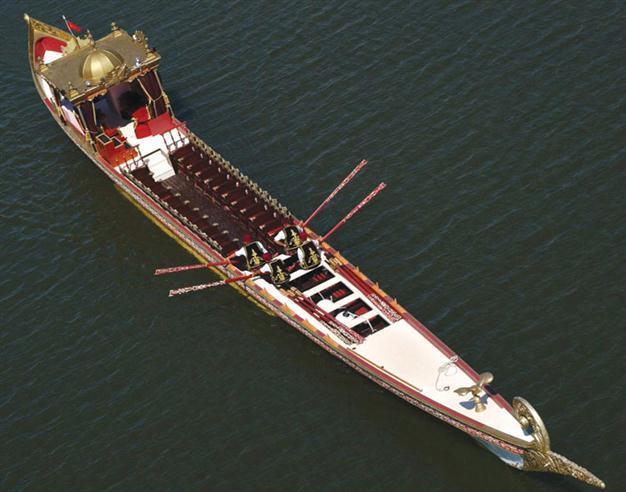Ottomans sail in style on the Bosphorus
NIKI GAMM ISTANBUL- Hürriyet Daily News

The maritime culture was highly developed in Ottoman Empire. Nearly a century earlier, travel writer Evliya Çelebi said there were 4,614 caiques in Istanbul and that approximately 8,000 people were engaged in this sector of the economy. That number did not diminish until the 19th century with the
introduction of motors and ferryboats.
“Let us give a little comfort to this heart that’s wearied so
Let us visit Sadabad, my swaying Cypress, let us go!
Look, there is a swift caique all ready at the pier below,
Let us visit Sadabad, my swaying Cypress, let us go!”
So says the
Ottoman poet Nedim at the beginning of the 18th century. Without tunnels and bridges, one could only cross the Bosphorus with boats of one form or another from
Istanbul’s earliest days until modern times. The only
transportation between the
European and
Asian sides of the city was by boat and most of these boats were traditional caiques, a name derived from the old
Turkish word “
kayık.”
Nearly a century earlier, travel writer
Evliya Çelebi said there were 4,614 caiques in Istanbul and that approximately 8,000 people were engaged in this sector of the economy. That number did not diminish until the 19th century with the introduction of motors and ferryboats.
“Just when the sun was setting in the west, we went down to the Golden Horn, got into a caique for two and sped away from the shore even before we could say ‘Galata!’ The caique is truly the most pleasant way to cross the water. It is longer than a gondola but narrower and more delicate, carved, painted and gilded.” This was how Italian travel writer Edmondo d’Amicis described his 19th century experience sailing in a caique on the Golden Horn.
Exemples of imperial caiques
One can see examples of the imperial caiques on display at the Naval Museum in Beşiktaş; of particular importance is a 17th century galley – a larger form of the caique – that has been restored. Caiques are sometimes also referred to as “sandals” and measured up to 30 to 32 meters in length and 2.5 to 3 meters in width. It could sometimes take as long as three months to build and decorate one with gold at the prow and stern engraved with flowers, leaves and other designs.
One or more golden eagles signifying the power of the man who was riding in it might be added to the design. Passengers would sit in the stern area; if a sultan were traveling, he would be under an open mini-kiosk made of wood, mother-of-pearl or of brass. This could also be covered with curtains if any Ottoman woman happened to be traveling. Also, if the sun were too bright, pillows would be laid down to sit under this kiosk. A screen would often separate the sultan from the oarsmen who would total between seven pairs of rowers to 20, depending on the size of the caique.
Bostancı Başı and chief gardenerThe man responsible for the imperial caiques was the Bostancı Başı, the chief gardener of the Ottoman palace, who had originally been engaged in planning and planting the gardens of Topkapı Palace in the second half of the 15th century. He was identifiable by his distinctive red cap. Later, however, his job expanded to cover all the imperial and public gardens in Istanbul. From there he was given the responsibility of tending to the shoreline around Istanbul and ensuring that orders were carried out any time the sultan sentenced someone to be punished by execution or exile.
He also was in charge of seeing that landings and boathouses were built and that the caiques were stored properly to protect them from inclement weather and sunshine. At the end of the 18th century, he is said to have had 2,500 men under his command. But despite his high position, he was required to man the tiller in the sultan’s caique whenever the Ottoman ruler chose to travel by water along the Bosphorus or the Golden Horn. Leaving aside the necessity of using a boat to go between the two continents, traveling by water was much more pleasant than making one’s way laboriously along unpaved inland roads. Istanbulites even today have a fondness for traveling by water and many small motorboats crisscross the Bosphorus where once imperial caiques ruled the waves.
